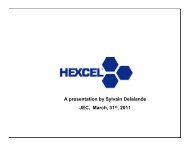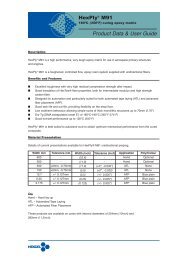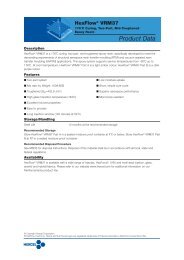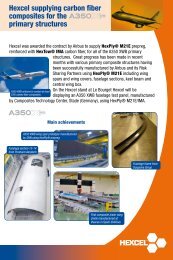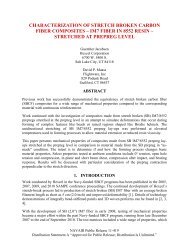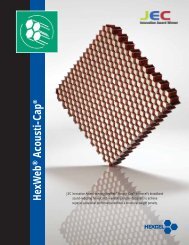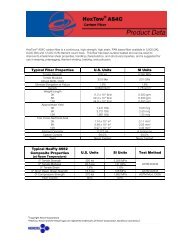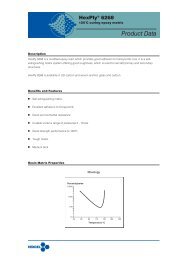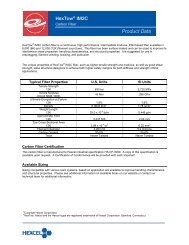failure initiation and effect of defects in structural ... - Hexcel.com
failure initiation and effect of defects in structural ... - Hexcel.com
failure initiation and effect of defects in structural ... - Hexcel.com
Create successful ePaper yourself
Turn your PDF publications into a flip-book with our unique Google optimized e-Paper software.
Figure 8. Pictures for tensile samples used to <strong>in</strong>spect the first cracks. “LP” notation denotes<br />
cracks detected by acoustic emission <strong>and</strong> liquid penetrant. “A” denotes locations where acoustic<br />
emission was detected, but liquid penetrant did not reveal surface cracks. Noted are the<br />
identification <strong>and</strong> first sound load<strong>in</strong>g for each sample.<br />
Out <strong>of</strong> the four specimens with verified surface cracks, only one had crack<strong>in</strong>g beyond the first<br />
few chip layers (PO2-6 LP1). Figure 9 shows the micrograph for this sample. In this case, the<br />
sample was loaded to 213 MPa (31 ksi), higher than any other sample, <strong>and</strong> several chips at this<br />
location were angled more than 45 degrees from the load direction.<br />
No <strong>in</strong>terior cracks could be found at locations with AE signals only. It is possible the cracks were<br />
cut through <strong>and</strong> destroyed, the marked locations were slightly <strong>of</strong>f, or crack sizes were so small<br />
they were not noticed. Table 1 summarizes the average chip angle at LP locations.<br />
Table 1. Chip angles at LP surface cracks. Angles are given relative to the load direction,<br />
<strong>com</strong>plementary angles are not differentiated. Angles were calculated visually based on the length<br />
<strong>of</strong> the major <strong>and</strong> m<strong>in</strong>or fiber axis.<br />
For crack locations with shallow angled surface chips, it was verified that cracks <strong>in</strong>itiated<br />
directly at chip end/edge. Figure 10 shows micrographs for samples PO2-3 LP2 <strong>and</strong> PO2-4 LP3.<br />
Both locations show cracks <strong>in</strong>itiat<strong>in</strong>g directly at a chip <strong>in</strong>terface, where there is a res<strong>in</strong> rich area.<br />
Some cracks <strong>in</strong>itiated as a result <strong>of</strong> preexist<strong>in</strong>g surface defect. Figure 11 shows a micrograph for<br />
crack PO2-4 LP1, which started from a surface void.




